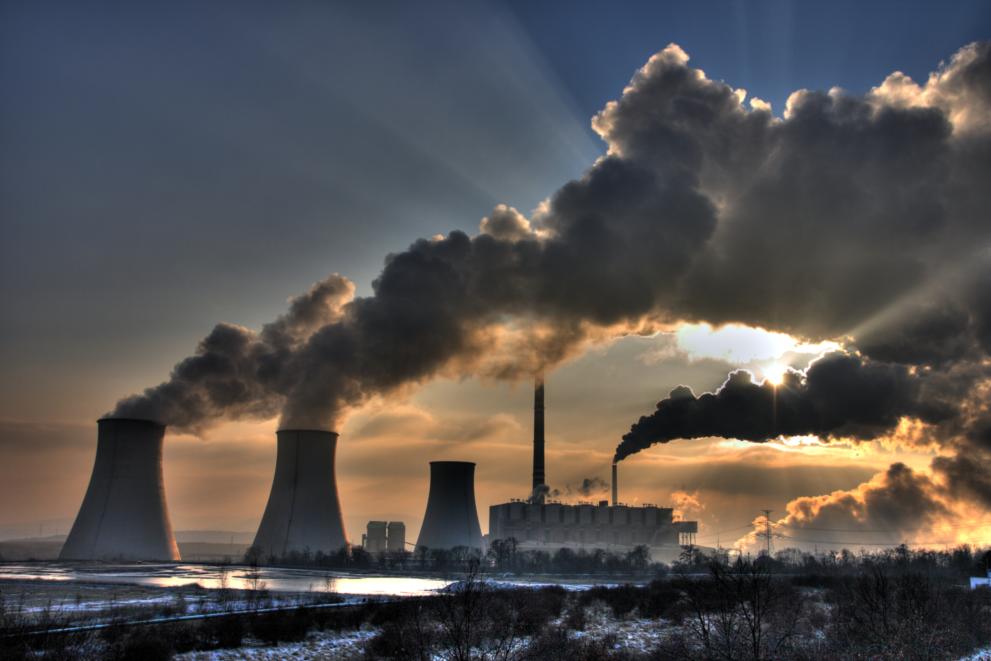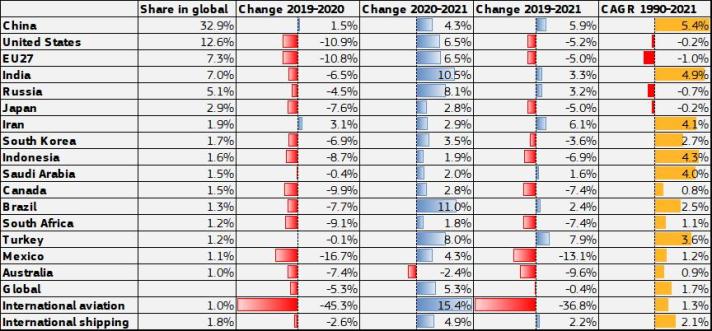
Global fossil CO2 emissions increased by 5.3% in 2021 as compared to 2020, almost reaching pre-pandemic 2019 levels, according to the 2022 report on CO2 emissions of all world countries, compiled by the JRC, the International Energy Agency (IEA) and the Netherlands Environmental Assessment Agency (PBL).
In the EU, total fossil CO2 emissions increased by 6.5% in 2021. However, this increase is just about half of the reduction that took place between 2019 and 2020 (-10.8%). Consequently, the EU27 emissions fell by 5% between 2021 and 2019, continuing a downward trend.
Looking further back, the EU has achieved the largest relative decrease in greenhouse gas emissions among the top emitters. EU27 fossil CO2 emissions in 2021 were 27.3% lower than in 1990 and its share of global emissions also decreased from 16.8% in 1990 to 7.3% in 2021.
The results of the report contribute to the Paris Agreement process with an independent and quantitative view of global emissions. They are based on the fossil CO2 emission time series in the Emissions Database for Global Atmospheric Research (EDGAR) from 1970 until 2021.
EDGAR complements national inventories and reporting prepared by Parties to the Paris Agreement. In particular, the EDGAR time series can provide information on collective emissions trends for all countries as required for the UN Framework Convention on Climate Change (UNFCCC) global stocktake in 2023.
Emissions across the world
In 2020, the COVID-19 crisis slowed down the global economy, resulting in a decrease of global CO2 emissions by about 5%. In 2021, global anthropogenic fossil CO2 emissions rebounded and by 5.3% in comparison of 2020, totalling 37.9 Gt CO2, just 0.36% below 2019 levels.
China, the United States, the EU27, India, Russia and Japan remained the world’s largest CO2 emitters. Together they account for 49.2% of global population, 62.4% of global Gross Domestic Product, 66.4% of global fossil fuel consumption and 67.8% of global fossil CO2 emissions. All six largest emitters increased their fossil CO2 emissions in 2021 compared to 2020, with India and Russia having the largest increases in relative terms (10.5% and 8.1%).
More broadly, among the 16 countries and regions each responsible for more than 1% of global emissions, seven countries - China, India, Russia, Iran, Saudi Arabia, Brazil and Turkey - have higher CO2 emissions in 2021 than in 2019 (before the pandemic), with Turkey showing the highest increase (+7.9%). By comparison, the EU27 and eight other countries – the United States, Japan, South Korea, Indonesia, Canada, South Africa, Mexico, and Australia – emitted less in 2021 than in 2019, with Mexico showing the largest decrease (-13%).
Background
The latest update of the EDGAR dataset was compiled in collaboration with IEA and PBL. For the first time, the report uses IEA calculated fossil-fuel CO2 emissions directly where appropriate, rather than calculating them from the underlying energy use statistics, to ensure greater coherence with the IEA data.
Moreover, for the first time, net global CO2 emissions associated with both wildfires, amounting to 0.66 GtCO2 in 2020 (as estimated by the Global Wildfire Information System, GWIS), and from Land Use, Land-Use Change and Forestry (LULUCF), amounting to a net sink of 3.9 GtCO2 in 2020, were also included and integrated in the EDGAR dataset.
It should be noted that LULUCF is an extremely complex sector to account for in terms of carbon emissions and removals, due to the inherent complexity of terrestrial ecosystems and the difficulty of disentangling anthropogenic and natural fluxes. For this reason, detailed country estimates of LULUCF sinks are not yet available in the current EDGAR version.
EDGAR completes the global picture with a time-series for each of 208 countries, contributing to enhanced transparency and providing an additional source with which national and global estimates can be compared.
Details
- Publication date
- 14 October 2022
- Author
- Joint Research Centre





